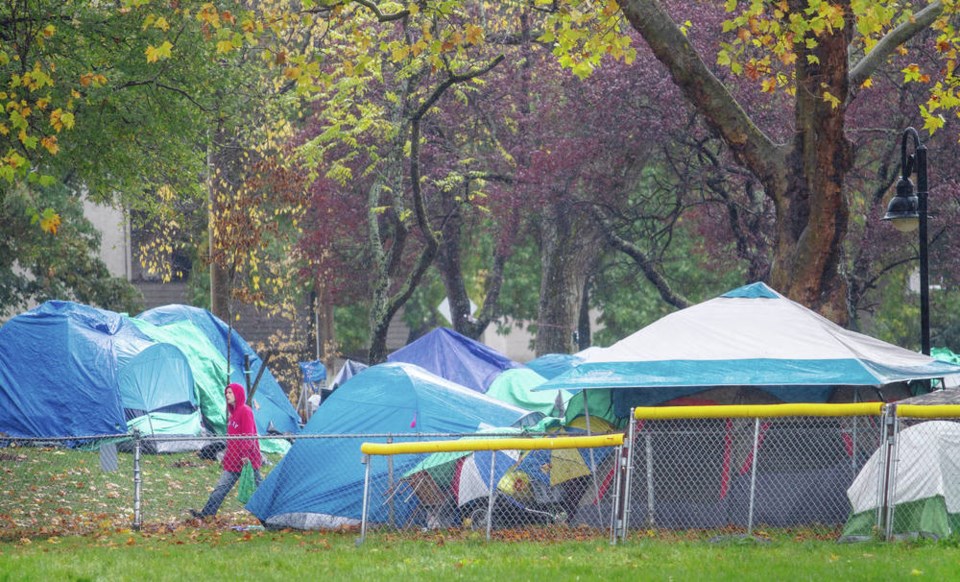People without homes are still crammed into Central Park near Crystal Pool, more than two months after Victoria council adopted new rules aimed at dispersing homeless encampments across the city.
As of Monday, the North Park Neighbourhood Association counted 73 structures in the park. That’s down from a high of about 120 in early October, but still five to six times the number allowed by the city’s parks bylaw.
Sarah Murray, the association’s executive director, said residents are frustrated, but “we also acknowledge that the city, and the bylaw department specifically, is working as fast as they can.
“This is just a really hard situation.”
The new rules, adopted by council on Sept. 14, restrict the size of tents to nine square metres and require them to be four metres apart and 50 metres from school property. It was initially thought the restrictions would allow up to 21 tents in the park, but that limit was reduced even further when council doubled the setback from playgrounds to eight metres.
Murray said bylaw officers initially succeeded in reducing the number of structures by about 40 per cent, largely by removing duplicate or vacant tents. In some cases, people moved to other parks.
“However, the progress has slowed somewhat and part of that is because the folks who were agreeable to distributing to the other parks have made their moves,” she said.
Some of the remaining people have more complex needs and others are reluctant to move to more isolated areas, farther away from the services they require.
“So we’re seeing what happens when you concentrate social services in the downtown core,” Murray said. “We’re seeing what happens when the only option for showers is on Pandora. We’re seeing what happens when meals are hard to come by and they’re going where the most number of people are [living].”
Shannon Perkins, the city’s manager of bylaw services, told council this week that there were about 50 people living in Central Park at last count — or about a quarter of all those sheltering outside in the city.
North Park residents say the number of structures in the park has ticked upwards again in recent days, even though the park is considered full and nobody else is supposed to be arriving.
“The thing is, people were moved out of the park, but it’s filling up faster than people are leaving,” said Sean Kahil, who lives across from Central Park and sits on the neighbourhood association’s board.
The board wrote to the city last month, urging action to reduce overcrowding in the park and requesting a deadline for bringing unhoused people into compliance with the new camping rules.
Mayor Lisa Helps said a team of people from bylaw services, B.C. Housing and non-profit agencies was in Central Park this week identifying the people living there, assessing their needs and helping them fill out housing applications.
“It’s not just as simple as shipping people off to other parks,” she said. “There needs to be an assessment of who they are and, as much as possible, who’s going where.”
Helps, who praised the North Park association’s work on the issue, acknowledged that the process is taking longer than many would like, but she insisted help is on the way. “Ideally, we won’t be moving people from park to park; we’ll be moving people from park into shelters or housing. That’s the real work that I’m focused on around the clock right now.”
Council has approved a plan by Helps and Coun. Jeremy Loveday to end 24/7 camping in parks by March 31 by finding housing or shelter for everyone currently living outside. But the Community Wellness Alliance of business, government and social service officials hopes to make significant progress long before then by moving 200 people indoors by Jan. 1.


